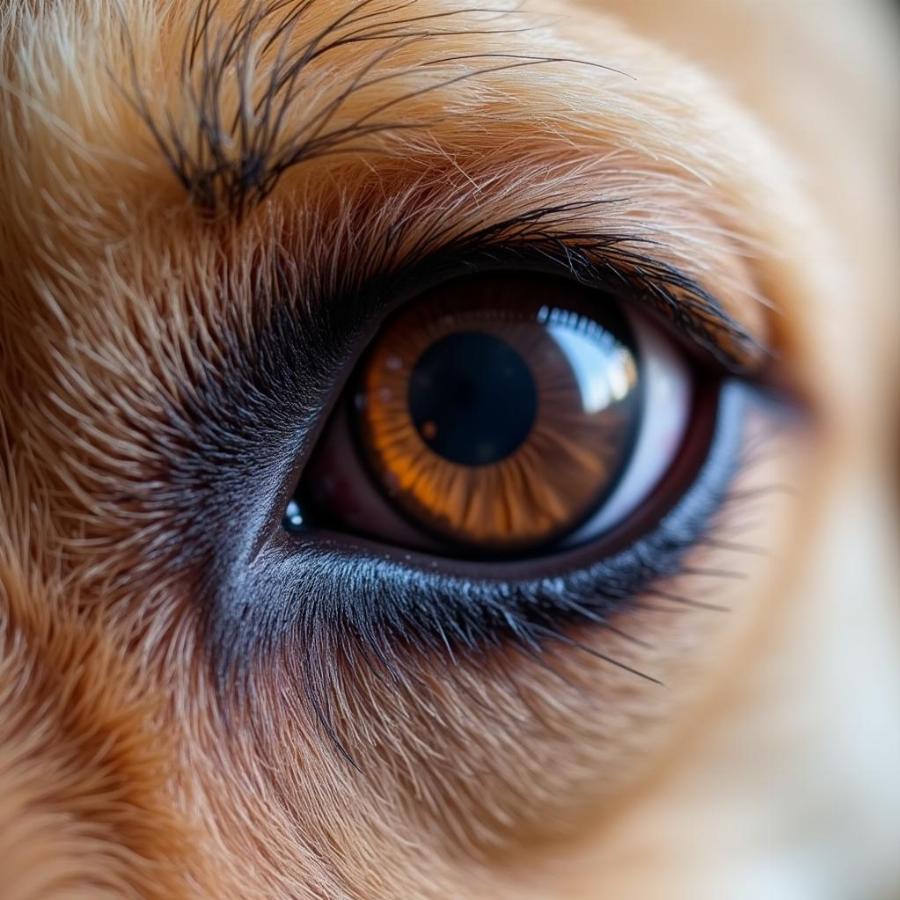A dog’s third eyelid, also known as the nictitating membrane, typically remains hidden. So, when your dog’s third eyelid is visible, it often signals an underlying health issue. This article will delve into the common causes, symptoms, and treatment options associated with a visible third eyelid in dogs.
Understanding the Dog’s Third Eyelid
The third eyelid serves as a protective shield for the eye, providing lubrication and clearing debris. It usually remains tucked away in the corner of the eye, only becoming apparent under certain circumstances. So, a protruding third eyelid isn’t a disease itself, but rather a symptom of another condition.
Common Causes of a Visible Third Eyelid in Dogs
Several factors can contribute to a dog’s third eyelid becoming visible. Some of the most common causes include:
- Hawthorne Syndrome: This involves the forward movement of the third eyelid, often accompanied by other symptoms like eye discharge and redness. It’s often caused by pain or inflammation within the eye itself.
- Tetraparesis: Muscle weakness, particularly affecting the facial muscles, can make it difficult for a dog to fully retract the third eyelid.
- Dehydration: A lack of sufficient fluids can lead to sunken eyes, making the third eyelid more prominent.
- Injury or Inflammation: Trauma or infection within the eye can irritate and inflame the tissues, causing the third eyelid to swell and become more noticeable.
- Foreign Body: Something lodged in the eye, like a piece of grass or dirt, can irritate the eye and cause the third eyelid to protrude.
- Certain Breeds: Some breeds, such as Bulldogs and Cocker Spaniels, are more prone to conditions that affect the third eyelid.
- Other Medical Conditions: More serious underlying issues, including tumors, nerve damage, or autoimmune diseases, can also cause the third eyelid to become visible.
 Dog with Visible Third Eyelid
Dog with Visible Third Eyelid
Symptoms Accompanying a Visible Third Eyelid
While the visible third eyelid itself is a symptom, it’s crucial to look out for other accompanying signs that can help pinpoint the underlying cause. These include:
- Excessive Tearing: The eye may produce more tears than usual.
- Discharge: A yellow or green discharge from the eye can indicate an infection.
- Redness and Swelling: The eye may appear red and inflamed.
- Squinting or Pawing at the Eye: These are signs of discomfort and potential pain.
- Changes in Pupil Size: One pupil may appear smaller or larger than the other.
- Sunken Eyes: This can indicate dehydration.
When to Seek Veterinary Attention
If your dog’s third eyelid is visible, especially if accompanied by other symptoms, it’s essential to consult a veterinarian. They can determine the underlying cause and recommend appropriate treatment.
Diagnosing the Cause
A veterinarian will perform a thorough physical exam and may conduct additional tests, such as blood work, tear tests, or eye pressure measurements, to reach a diagnosis.
Treatment Options for a Visible Third Eyelid in Dogs
Treatment depends on the underlying cause. It may involve:
- Medications: Antibiotics for infections, eye drops for inflammation, or other medications to address the underlying condition.
- Surgery: In some cases, surgery may be necessary to correct structural abnormalities or remove foreign bodies.
- Supportive Care: This includes keeping the eye clean and lubricated, ensuring adequate hydration, and providing pain relief if necessary.
How Can I Tell if My Dog’s Third Eyelid is a Problem?
A temporarily visible third eyelid may not be cause for immediate concern. However, if it persists for more than a few hours or is accompanied by other symptoms like discharge, redness, or squinting, it’s time to seek veterinary advice.
Conclusion
A visible third eyelid in dogs is a sign that something isn’t quite right. While it might be a minor issue, it can also indicate a more serious underlying condition. Prompt veterinary attention is crucial for diagnosis and appropriate treatment to ensure your dog’s eye health and overall well-being. Remember, early intervention often leads to the best outcomes.
FAQ
- Is a visible third eyelid always a sign of a serious problem? No, sometimes it can be temporary, but persistent visibility warrants a vet visit.
- Can dehydration cause a visible third eyelid? Yes, dehydration can lead to sunken eyes, making the third eyelid more prominent.
- What breeds are more prone to third eyelid issues? Breeds like Cocker Spaniels, Bulldogs, and Beagles are more predisposed.
- What are the treatment options for a cherry eye (prolapse of the third eyelid gland)? Treatment typically involves surgical repositioning of the gland.
- Can I treat my dog’s visible third eyelid at home? No, it’s essential to consult a veterinarian for diagnosis and treatment.
Do you have more questions? Check out these related articles:
Beaut Dogs: Your Trusted Source for Canine Care
Beaut Dogs is your one-stop resource for everything related to dog care, offering expert advice and valuable insights into the world of canines. From breed information to health and training tips, we provide a wealth of knowledge to help you care for your furry friend. When you need assistance, contact us at Email: [email protected] to get detailed and accurate answers from Beaut Dogs. We’re here to support you every step of the way. Visit https://beautdogs.com to learn more!